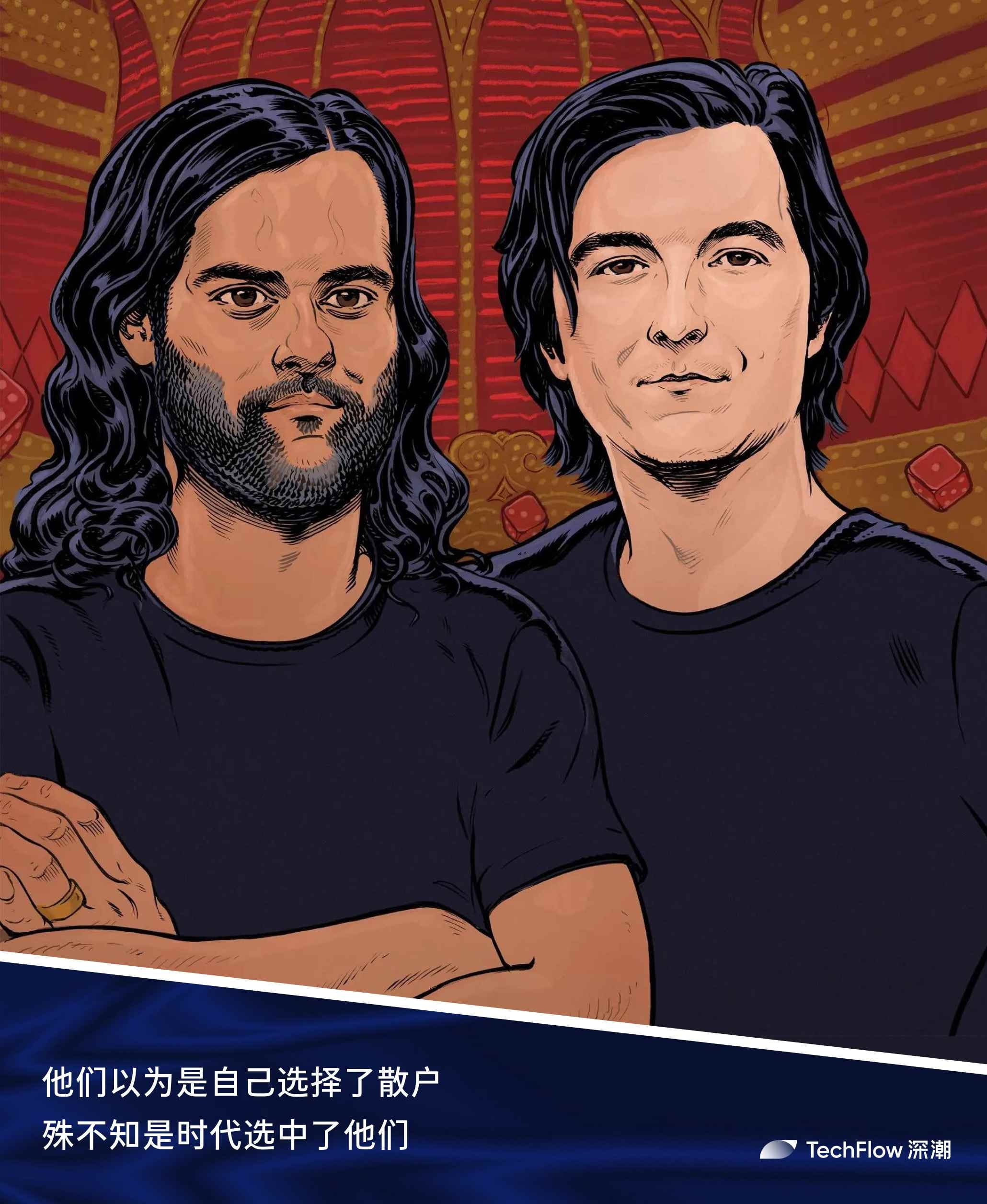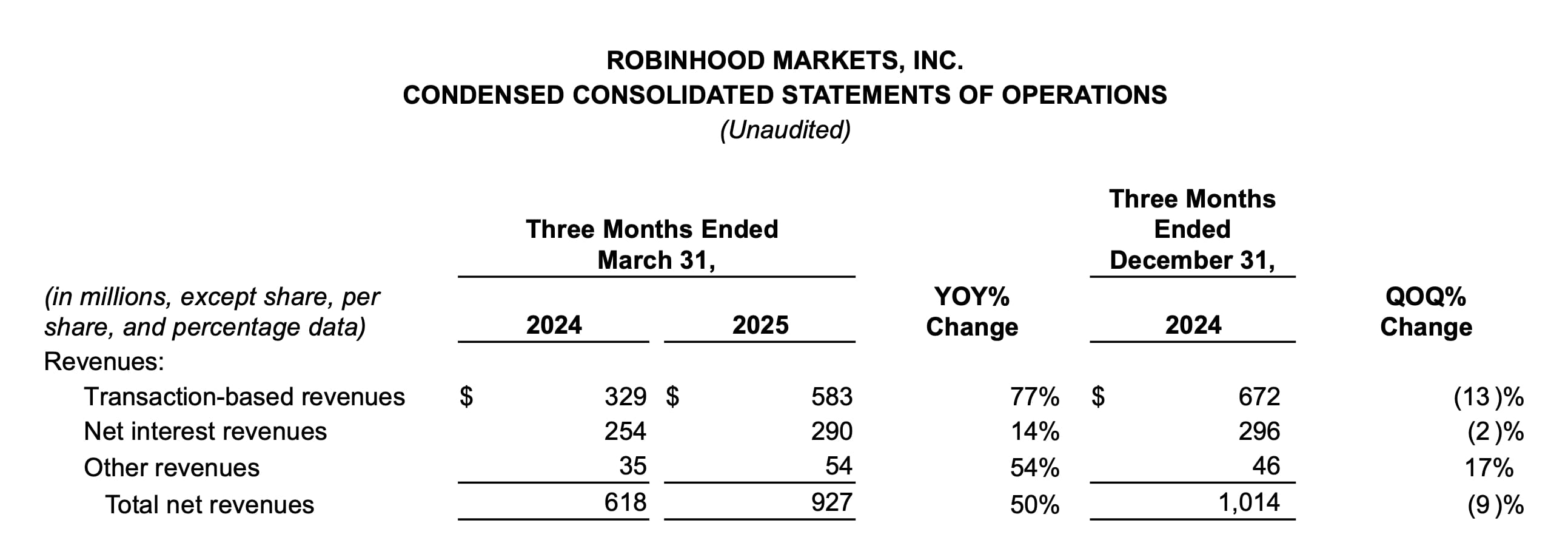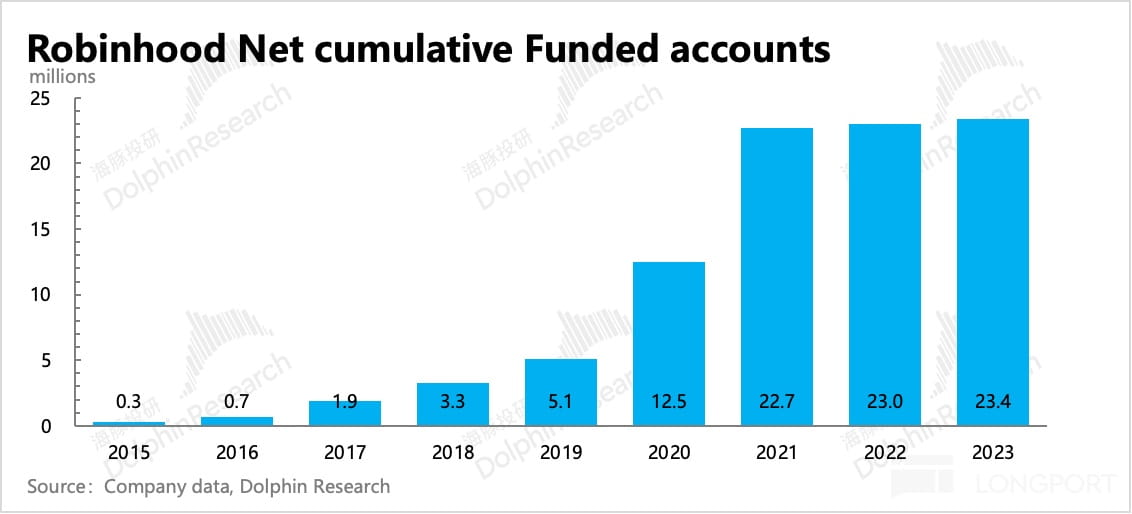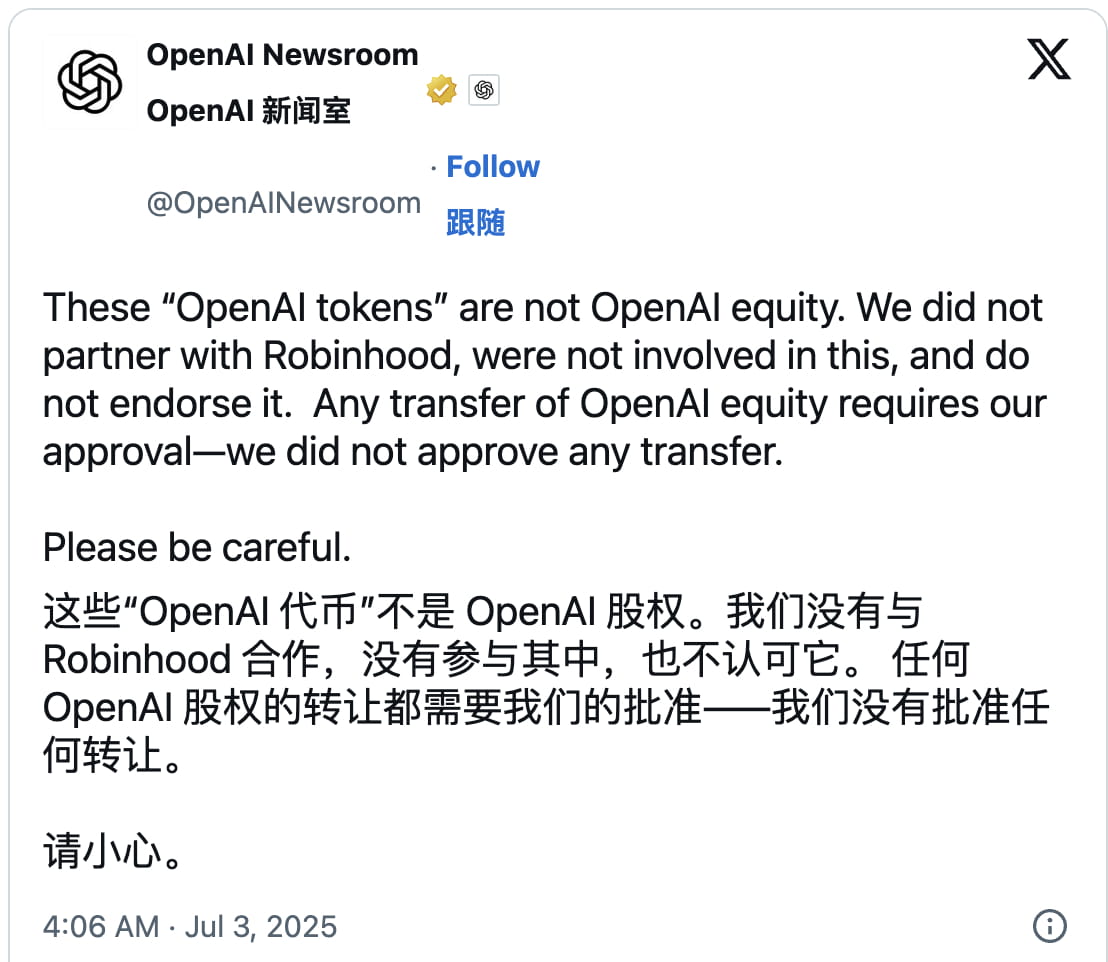Written by: Yanz, Liam

'A good financial person, the 'Robin Hood' of finance,' a friend once described Tenev (Vladimir Tenev).
Later, this nickname became the name of a company that changed the financial industry. However, this was not yet the beginning of the whole story.
Tenev (Vladimir Tenev) and Bhatt (Baiju Bhatt), founders with backgrounds in mathematics and physics from Stanford University, met during a summer research project in their undergraduate studies at Stanford.
Neither of them anticipated that their future would be deeply intertwined with a generation of retail investors; they thought they chose retail investors, but in reality, it was the era that chose them.

During his studies at Stanford, Tenev began to question the prospects of mathematical research. He grew tired of an academic life where one could spend years studying a problem only to find nothing, and he could not understand why his PhD classmates were willing to work hard for meager incomes. It was this reflection on traditional paths that quietly planted the seeds of his entrepreneurship.
In the autumn of 2011, coinciding with the peak of the 'Occupy Wall Street' movement, public discontent with the financial industry reached its zenith. In Zuccotti Park in New York, tents of protesters were scattered, and far away in San Francisco, Tenev and Bhatt, standing in front of their office windows, could also see the ripples of this scene.
That same year, they founded a company called Chronos Research in New York to develop high-frequency trading software for financial institutions.
However, they quickly realized that traditional brokers kept ordinary investors out of the financial market by leveraging high commissions and cumbersome trading rules. This led them to ponder: can technology that serves institutions also serve retail investors?
At that time, emerging mobile internet companies like Uber, Instagram, and Foursquare were on the rise, and products designed specifically for mobile began to lead the trend. In contrast, the financial industry struggled to adapt to mobile devices, with low-cost brokers like E-Trade still finding it difficult.
Tenev and Bhatt decided to align with this wave of technology and consumption, transforming Chronos into a free stock trading platform for millennials and applying for a broker-dealer license.
Millennials, the internet, and free trading—Robinhood has gathered the three most disruptive elements of this era.
At that time, they did not anticipate that this decision would open the door to an extraordinary decade for Robinhood.
Hunting Millennials
Robinhood set its sights on a blue ocean market that was overlooked by traditional brokers at the time—the millennial generation.
A survey conducted by traditional financial advisory firm Charles Schwab in 2018 showed that 31% of investors would compare fees when choosing a brokerage firm. Millennials are particularly sensitive to 'zero fees,' with over half of respondents stating they would switch to a more price-advantageous platform because of this.
Zero-commission trading emerged against this backdrop. At that time, traditional brokers typically charged $8 to $10 per trade, but Robinhood completely eliminated this fee and set no minimum account funding requirement. The model of trading for as little as one dollar quickly attracted a large number of novice investors, combined with a simple and intuitive interface design that even had a 'gamified' feel, Robinhood successfully increased user trading activity and cultivated a group of 'trading-obsessed' young users.
This transformation of the charging model ultimately forced the industry to evolve. In October 2019, Fidelity, Charles Schwab, and E-Trade announced they would reduce each trade commission to zero. Robinhood became the 'first person' to carry the zero-commission banner.

Source: Orient Securities
Utilizing Google's Material Design style launched in 2014, Robinhood's gamified interface design even won an Apple Design Award, becoming the first financial technology company to receive such an honor.
This is part of the success, but not the most critical aspect.
In an interview, Tenev described the company's philosophy by quoting a line from the character Gordon Gekko in the movie 'Wall Street': 'The most important commodity that I have is information.'
This statement encapsulates the core of Robinhood's business model—payment for order flow (PFOF).
Like many internet platforms, the 'free' facade of Robinhood actually comes with a much steeper price.
It profits by selling users' trading order flow to market makers, but users may not necessarily get the best market prices and think they are benefiting from commission-free trading.
In simple terms, when users place orders on Robinhood, these orders are not sent directly to the public market (like Nasdaq or the NYSE) to be executed; instead, they are first forwarded to market makers that partner with Robinhood (like Citadel Securities). These market makers trade at extremely small price differences (usually a difference of one-thousandth of a cent) and profit from the trades. In return, market makers pay Robinhood 'payment for order flow,' which is the order flow payment.
In other words, Robinhood's free trading actually earns money in 'invisible' ways for users.
Despite founder Tenev repeatedly stating that payment for order flow (PFOF) is not a source of Robinhood’s profits, the reality is: in 2020, 75% of Robinhood's revenue came from trading-related businesses, and by the first quarter of 2021, this number rose to 80.5%. Even though the proportion has slightly declined in recent years, PFOF remains an important pillar of Robinhood's revenue.

Adam Alter, a marketing professor at NYU, bluntly stated in an interview: 'For a company like Robinhood, simply having users is not enough. You must get them to continuously click the 'buy' or 'sell' buttons, lowering all the barriers they might encounter when making financial decisions.'
Sometimes, this extreme experience of 'lowering thresholds' brings not just convenience but also potential risks.
In March 2020, 20-year-old American college student Kahns discovered a loss of up to $730,000 on his account after trading options on Robinhood—far exceeding his $16,000 principal. This young man ultimately chose to take his own life, leaving a note for his family that read: 'If you are reading this letter, I am no longer here. Why can a 20-year-old with no income access nearly $1 million in leverage?'
Robinhood precisely tapped into the psychology of young retail investors: low barriers, gamification, and social attributes, and it enjoyed the returns brought by this design. By March 2025, the average age of Robinhood users remained stable at around 35 years old.
But everything that fate bestowed comes with a price tag, and Robinhood is no exception.
Robin Hood, robbing the rich to help the poor?
From 2015 to 2021, the number of registered users on the Robinhood platform grew by 75%.
Especially in 2020, alongside the COVID-19 pandemic, U.S. government stimulus policies, and a nationwide investment craze, the platform's user base and trading volume soared, with managed assets briefly exceeding $135 billion.

The surge in user numbers was accompanied by disputes.
At the end of 2020, the Massachusetts Securities Regulator accused Robinhood of using 'gamification' techniques to attract inexperienced users while failing to provide necessary risk controls during market volatility. Following that, the SEC also launched an investigation into Robinhood, accusing it of not securing the best trading prices for users.
In the end, Robinhood chose to pay $65 million to settle with the SEC. The SEC bluntly pointed out that even considering the commission-free incentive, users overall still lost $34.1 million due to price disadvantages. Robinhood denied the allegations, but this storm was bound to be just the beginning.
What truly drew Robinhood into the public opinion whirlpool was the GameStop incident in early 2021.
This video game retailer, which carries the childhood memories of a generation of Americans, found itself in trouble due to the pandemic and became a target for institutional investors to short-sell heavily. However, thousands of retail investors refused to watch GameStop be crushed by capital. They rallied on the Reddit forum WallStreetBets, collectively buying through trading platforms like Robinhood, igniting a 'retail investor short-squeeze' battle.
GameStop's stock price skyrocketed from $19.95 on January 12 to $483 on January 28, an increase of over 2300%. A financial frenzy of 'grassroots resistance against Wall Street' shook the traditional financial system.
However, this seemingly retail victory quickly turned into Robinhood's 'darkest moment.'
The financial infrastructure of that year could not handle the sudden surge in trading frenzy. According to the settlement rules at the time, stock trades required T+2 days to settle, and brokers had to reserve risk margins for users' trades in advance. The skyrocketing trading volume caused Robinhood's margin payments to clearinghouses to surge.
On the morning of January 28, Tenev was awakened by his wife, learning that Robinhood had received a notice from the National Securities Clearing Corporation (NSCC) requiring it to pay up to $3.7 billion in risk margins, pushing Robinhood's funding chain to its limit instantly.
He contacted venture capitalists overnight, raising funds to ensure the platform was not dragged down by systemic risks. Meanwhile, Robinhood was forced to take extreme measures: limiting purchases of 'meme stocks' like GameStop and AMC, allowing users to sell only.
This decision immediately ignited public outrage.

Millions of retail investors felt that Robinhood betrayed its promise of 'financial democratization,' criticizing it for bowing to Wall Street forces. There were even conspiracy theories accusing Robinhood of colluding with Citadel Securities (its largest order flow partner) to manipulate the market in order to protect hedge fund interests.
Online abuse, death threats, and a barrage of negative reviews followed one after another. Robinhood suddenly transformed from 'friend of retail investors' to the target of criticism; Tenev's family was forced to go into hiding and hired private security.
On January 29, Robinhood announced it had urgently raised $1 billion to maintain operations, followed by several rounds of financing, ultimately raising a total of $3.4 billion. Meanwhile, members of Congress, celebrities, and public opinion pursued it relentlessly.
On February 18, Tenev was summoned to testify before the U.S. Congress, and when faced with questions from lawmakers, he insisted that Robinhood's decision was made under settlement pressure and had nothing to do with market manipulation.
Nonetheless, doubts never ceased. The Financial Industry Regulatory Authority (FINRA) conducted a thorough investigation of Robinhood, ultimately imposing the largest single fine in history—$70 million, which included $57 million in penalties and $13 million in customer compensation.
The GameStop incident became a turning point in Robinhood's history.
This financial storm severely damaged Robinhood's image as a 'retail protector,' and both brand reputation and user trust suffered a heavy blow. For a time, Robinhood became a 'survivor in the cracks,' both unsatisfactory to retail investors and monitored by regulators.
However, this incident also prompted U.S. regulators to reform the clearing system, pushing the settlement period from T+2 to T+1, bringing long-term impacts to the entire financial industry.
After this crisis, Robinhood proceeded with its long-prepared IPO.
On July 29, 2021, Robinhood went public on Nasdaq under the code 'HOOD,' with an issue price set at $38, valuing the company at about $32 billion.
However, the IPO did not bring the expected capital feast to Robinhood. On its first day of trading, the stock price opened lower and ultimately closed at $34.82, an 8% drop from the issue price. Although it later saw a brief recovery due to retail investor enthusiasm and institutional buying (like ARK Invest), the overall trend remained under pressure for a long time.
The divergence between Wall Street and the market is evident—whether to view it as a 'financial gateway for retail investors' or to worry about its controversial business model and future regulatory risks.
Robinhood stood at the crossroads of trust and suspicion, officially stepping into the real test of the capital market.
But at that time, few noticed a signal hidden between the lines of the prospectus—within the S-1 document submitted by Robinhood, the word 'Crypto' was mentioned repeatedly 318 times.
The frequent appearances, seemingly casual, were actually a declaration of a strategic shift.
Crypto is indeed the new narrative that Robinhood has quietly launched.
Colliding with crypto
As early as 2018, Robinhood had quietly begun exploring cryptocurrency business, first launching Bitcoin and Ethereum trading services. At that time, this layout was more of a product line supplement, far from becoming a core strategy.
But the market's enthusiasm quickly changed everything.
In 2021, (The New Yorker) described Robinhood as: 'A zero-commission platform that provides both stocks and cryptocurrency trading, aiming to be an enlightened version of Wall Street, bearing the mission of 'achieving financial democratization for all.'
The growth of data also confirms the potential of this track:
In the fourth quarter of 2020, about 1.7 million users traded cryptocurrencies on the Robinhood platform; by the first quarter of 2021, this number soared to 9.5 million, growing more than fivefold in a single quarter.
In the first quarter of 2020, cryptocurrency trading revenue accounted for about 4% of the company's total trading revenue. By the first quarter of 2021, this figure skyrocketed to 17%, and in the second quarter, it exploded to 41%.
Starting with only $4.15 million in cryptocurrency assets in 2019, by the end of 2020, this figure had surged to $35.27 million, growing over 750%. Entering the first quarter of 2021, managed assets soared to $1.16 billion, a year-on-year increase of over 2,300%.

At this moment, cryptocurrency has transformed from a fringe product into one of Robinhood's revenue pillars, clearly positioned as a growth engine. As they stated in their documents: 'We believe that cryptocurrency trading opens new avenues for our long-term growth.'
But what exactly happened that allowed Robinhood's cryptocurrency business to explode in growth in just one or two quarters?
The answer appeared in the S-1 prospectus. Remember the crazy Dogecoin surge in 2021? Robinhood was indeed a driving force behind the Dogecoin wave.
The S-1 document explicitly stated: 'During the three months ending June 30, 2021, 62% of cryptocurrency trading revenue came from Dogecoin, compared to 34% in the previous quarter.'
To meet user demands, Robinhood announced plans to launch cryptocurrency deposit and withdrawal features in August 2021, allowing users to freely transfer assets like Bitcoin, Ethereum, and Dogecoin in and out of wallets.
Half a year later, at the LA Blockchain Summit, Robinhood officially launched the beta version of Robinhood Wallet, which supports multiple chains, opened it to iOS users in September 2022, and fully launched it in 2023.
This move marked the official beginning of Robinhood's transformation from a 'centralized brokerage' to a 'digital asset platform.'
However, just as Robinhood was accelerating its transformation through the cryptocurrency boom, a man who was then quite legendary set his sights on it—Sam Bankman-Fried (SBF).
The then-prominent founder and CEO of FTX was known for his aggressive expansion tactics and disruptive ambitions in the financial industry.
In May 2022, SBF quietly bought approximately 7.6% of Robinhood shares through his holding company Emergent Fidelity Technologies, valued at about $648 million.
After the news became public, Robinhood's stock price surged over 30% in after-hours trading.
In the 13D filing submitted to the U.S. Securities and Exchange Commission (SEC), SBF stated that he bought into Robinhood because he 'considered it an attractive investment' and promised that he currently had no plans to seek control or interfere with management. However, the document also reserved the statement that 'future intentions regarding holdings may be adjusted based on circumstances,' leaving ample operational space.

In fact, SBF's actions are hard to interpret simply as a financial investment.
At that time, FTX was actively laying out the U.S. compliance market, trying to shed its identity as a 'pure cryptocurrency exchange' and penetrate traditional finance and securities business. Robinhood, with its massive retail user base and compliance credentials, was the ideal bridge.
There were rumors that SBF intended to push for deeper cooperation with Robinhood, even attempting a merger. Although SBF publicly denied this rumor, he never ruled out the possibility for the future.
However, SBF's layout did not bring the ideal 'win-win' outcome.
At the end of 2022, FTX collapsed, and SBF was embroiled in fraud, money laundering, and financial crime allegations. In January 2023, the U.S. Department of Justice officially seized approximately 56 million shares of Robinhood owned by SBF through his holding company, valued at around $465 million at the time.
What was originally a symbol of 'crypto-financial alliance' ultimately became a hot potato of legal evidence.
It wasn't until September 1, 2023, that Robinhood completely resolved the potential equity risk by repurchasing this batch of shares from the U.S. Marshals Service (USMS) for $605.7 million.
Ironically, based on Robinhood's current market value of $86 billion, the 7.6% stake previously held by SBF, if maintained to today, would have risen to about $6.5 billion, more than a tenfold increase from the original cost.
It turns out that this so-called 'attractive investment' by SBF is indeed quite alluring.
Rise, stock price
If the GameStop incident was a baptism of crisis for Robinhood, then 2025 marked the beginning of its own glorious moment.
All of this had long been foretold.
In the fourth quarter of 2024, Robinhood's key metrics reached new highs:
Managed assets, net deposits, gold subscription user numbers, revenue, net profit, adjusted EBITDA, and earnings per share all exceeded expectations;
Quarterly revenue surpassed $1.01 billion, net profit reached $916 million, gold subscription users exceeded 2.6 million, and adjusted EBITDA hit $613 million...
Cryptocurrency trading volume surged to $71 billion, with crypto business revenue increasing by 700% year-on-year, generating as much as $358 million in a single quarter.
Notably, in the fourth-quarter earnings report, Robinhood founder Tenev stated: 'We see the immense opportunity before us because we are working to enable anyone, anywhere, to buy, sell, or hold any financial asset and make any financial transaction through Robinhood.'
This is probably a small foreshadowing.
On February 14, 2025, just two days after the earnings report was released, Robinhood's stock price reached its first peak of 2025 at $65.28.

But what truly ignited this stock price frenzy was the resonance between global finance and the crypto market.
With Trump's election and a shift in U.S. policy to 'crypto-friendly,' the regulatory risks for Robinhood gradually diminished.
On February 21, 2025, the U.S. SEC's enforcement department officially notified Robinhood Crypto that it was ending a year-long investigation into its crypto business, custody processes, and payment order flow, and decided not to take any enforcement action. This letter not only cleared the policy obstacles for Robinhood's future expansion in cryptocurrency but also became an important catalyst for the stock price's breakthrough rebound.
Immediately after, Robinhood delivered a powerful blow.
On June 2, 2025, Robinhood officially announced the completion of its acquisition of Bitstamp, one of the oldest cryptocurrency exchanges in the world, for $65 million.
Bitstamp was renamed 'Bitstamp by Robinhood' and fully integrated into the Robinhood Legend and Smart Exchange Routing systems. This strategic acquisition not only provided Robinhood with a ticket to compliance assets and global market layout but also propelled it from a retail brokerage to compete on the global stage alongside Coinbase and Binance.
The next day, the stock price broke through $70.
If the acquisition of Bitstamp was an important step for Robinhood to go global, the subsequent actions declared that Robinhood was making a significant leap into the Web3 capital market.
Do you remember Tenev's earlier prediction? 'Anyone, anytime, any financial asset, any transaction, take it a step further.'
On June 30, 2025, Robinhood announced its official entry into the blockchain securities field, allowing European users to trade over 200 U.S. stocks and ETFs based on blockchain tokens on the Arbitrum network, including stocks of well-known companies like Nvidia, Apple, and Microsoft.
Not only that, but Robinhood also announced the development plan for its self-developed Layer-2 blockchain 'Robinhood Chain.'
The market reacted significantly, with Robinhood's stock price surging on a single day, reaching a 46% gain for the month and breaking the $100 mark during intraday trading on July 2, setting a new historical high.
Although the market later experienced a brief pullback due to rumors of OpenAI's equity tokenization being debunked, analysts generally believe that Robinhood has completed a stunning transformation from 'retail brokerage' to 'financial technology platform,' with blockchain securities set to become its next long-term growth engine.

As of now, Robinhood's stock price remains firmly around $100, with a year-to-date increase of nearly 150%, and its market value has surpassed $88 billion (approximately 630 billion RMB), far exceeding initial expectations at the time of its listing.
From grassroots to today's $86.7 billion market capitalization, Robinhood has changed dramatically. From being the target of criticism during the GameStop storm in 2021 to becoming a trendsetter amid the financial and crypto fusion wave in 2025, Robinhood not only endured the ultimate test of the capital market but also completed its accelerated reconstruction in five years.
If history chose Robinhood back then, at this moment, Robinhood finally became the player that could lead history.
Today, Tenev can probably tell his college self, who worried about mathematics as a career: 'You also spent years exploring a specific problem and finally didn’t come away empty-handed.'

